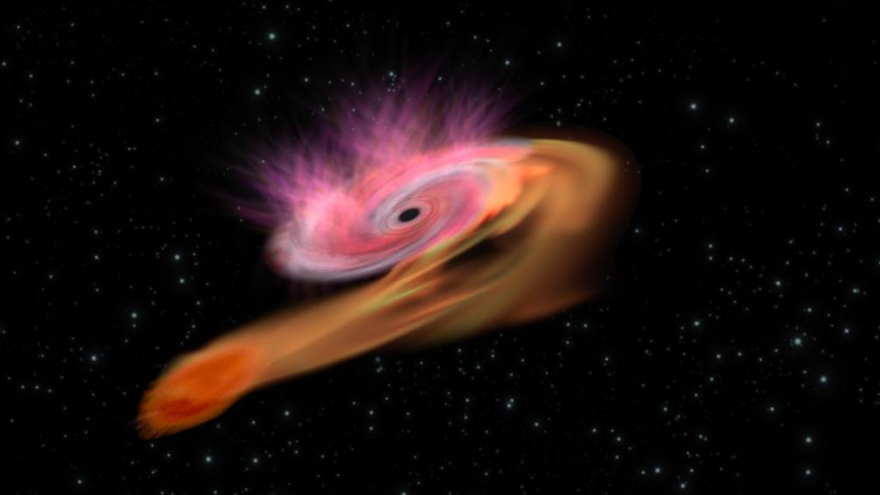Truth matters. Community matters. Your support makes both possible. LAist is one of the few places where news remains independent and free from political and corporate influence. Stand up for truth and for LAist. Make your year-end tax-deductible gift now.
Scientists just discovered a rogue black hole wandering in deep space

A star met a violent end in a galaxy far, far away — about 600 million light-years from Earth. It wandered too close to a black hole and was ripped apart in a bright burst of light. That much isn’t unusual, but what stunned astronomers was where it happened: not in the dense center of the galaxy, but thousands of light years away.
Astronomers at UC Berkeley discovered a massive black hole actively devouring a star outside of a galaxy’s central core — a cosmic spectacle known as a tidal disruption event, or TDE. This recent discovery may help astronomers uncover a hidden population of wandering black holes quietly roaming the outskirts of galaxies.
A tidal disruption event occurs when a star drifts too close to a black hole and gets “spaghettified” — stretched and torn by intense gravitational forces. The process releases a burst of light that can outshine an entire galaxy for weeks or months.

Traditionally, astronomers have observed black holes consuming stars only in the center of a galaxy, where supermassive black holes — like the Milky Way’s own Sagittarius A* — tend to reside. Advanced telescopes have recorded approximately 100 TDE events so far, but this is the first time a photo has been captured of one offset from the center of a galaxy.
“Every 30,000 years, there can be a star that’s coming close to the wandering black hole. Their orbit comes too close, and they will be tidally disrupted, producing a TDE,” said Yuhan Yao, a Miller Postdoctoral Fellow at UC Berkeley and lead author of the recent study.
“But this is the first one that was discovered in the optical wavelengths,” Yao said, referring to the visible light that human eyes can perceive. “It’s very hard to find these wandering black holes, and a TDE gives us a way to do it,” Yao said.
This new flare, dubbed AT2024tvd, was spotted far from the galaxy’s center using the Zwicky Transient Facility, a telescope located in San Diego designed to detect sudden changes in the night sky. The event’s unusual location was later confirmed by high-resolution images taken by the Hubble Space Telescope, which pinpointed the flare’s origin well outside the galactic center.
The discovery is more than just a cosmic oddity — it provides a new window into a hidden population of wandering black holes in our galaxies. Astronomers have long theorized that rogue supermassive black holes should exist, particularly as a byproduct of two or more galaxies colliding and blending over billions of years.
During such galactic mergers, smaller galaxies — and the black holes they carry — can become gravitationally displaced, wandering the larger galaxy for eons before eventually settling into its core or merging with other black holes.
“These events hold great promise for illuminating the presence of massive black holes that we would otherwise not be able to detect,” said Ryan Chornock, an astronomy professor at UC Berkeley. With this latest event, scientists now have direct, observable proof.
Why this black hole is so far from the galaxy’s heart remains a mystery. Scientists have a theory that it could have been flung from the center during a violent three-body interaction involving multiple black holes. Another idea is that it came from a smaller satellite galaxy that merged with the current one, leaving the black hole stranded midstream.

“The origin is more complicated in this scenario, and they [the black holes] are so close that maybe in the very far future they can merge, producing gravitational waves. But that’s very far in the future, that’s not within our lifetime,” Yao said.
Whatever its origin, this rogue black hole may not remain isolated forever. A black hole merger that could release these powerful gravitational waves that Yao mentioned could one day be detected by future space-based observatories like the Laser Interferometer Space Antenna, or LISA, set to launch in 2035.
Yao said she’s looking forward to the first images captured by the Vera Rubin Observatory in Chile, home to the 8.4-meter Simonyi Survey telescope, the largest digital camera ever built, that will survey the southern sky every week beginning this year. “In the future, with the Rubin Observatory, we will be able to find many more tidal disruption events. Because it has better sensitivity, we can probe a much larger distance, the bigger volume of the universe. I’m very excited about using that facility for my future research.”










